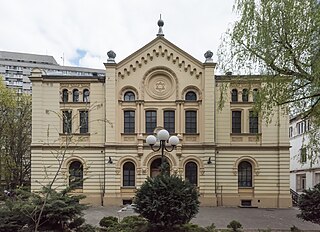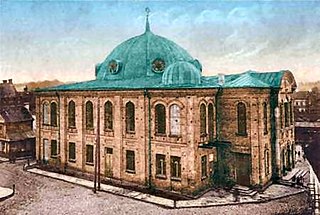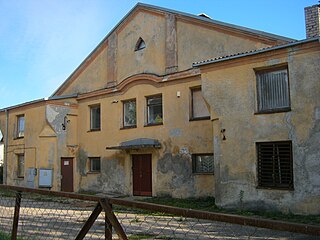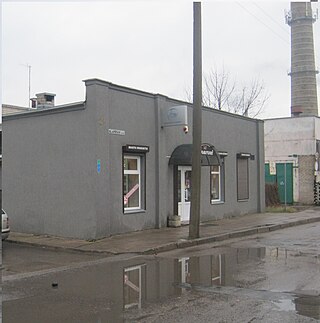Great Synagogue or Grand Synagogue may refer to current or former synagogues in the following countries;

A synagogue, also called a shul or a temple, is a place of worship for Jews and Samaritans. It has a place for prayer where Jews attend religious services or special ceremonies such as weddings, bar and bat mitzvahs, choir performances, and children's plays. They also have rooms for study, social halls, administrative and charitable offices, classrooms for religious and Hebrew studies, and many places to sit and congregate. They often display commemorative, historic, or modern artwork alongside items of Jewish historical significance or history about the synagogue itself.

Lviv is the largest city in western Ukraine, as well as the sixth-largest city in Ukraine, with a population of 717,500. It serves as the administrative centre of Lviv Oblast and Lviv Raion, and is one of the main cultural centres of Ukraine. Lviv also hosts the administration of Lviv urban hromada. It was named after Leo I of Galicia, the eldest son of Daniel, King of Ruthenia.

The Great Synagogue of Warsaw was a former Orthodox Jewish congregation and synagogue, that was located on Tłomackie street, in Warsaw, in the Masovian Voivodeship of Poland. Designed by Leandro Marconi and completed in the Neoclassical style in 1878, at the time of its opening, it was the largest Jewish house of worship in the world. The grand synagogue served as a house of prayer until World War II when it was destroyed by Nazis on May 16, 1943.

The Nożyk Synagogue is an Orthodox Jewish congregation and synagogue, located at 6 Twarda Street, in the Śródmieście district of Warsaw, in the Masovian Voivodeship of Poland.

The Zamość Synagogue, also the Zamość Old Synagogue or the Great Synagogue of Zamość, is a former Jewish congregation and synagogue, located in Zamość, in Lublin Voivodeship, Poland. Completed in 1618 in the Renaissance style, the synagogue is a UNESCO-protected World Heritage Site of Poland. Erected during the times of the Polish–Lithuanian Commonwealth, it functioned as a place of worship for Polish Jews until World War II, when the Nazis turned the interior into a carpenters' workshop. The structure was spared from destruction and in 1992 was listed as a World Heritage Site as part of the Old City of Zamość.

The Great Synagogue was a former Orthodox Jewish congregation and synagogue, that was located in Białystok, in Podlaskie Voivodeship, Poland. The synagogue building was designed by Szlojme Rabinowicz and completed in 1913. The building served as a house of prayer until World War II when it was destroyed by Nazis on June 27, 1941. It was estimated that approximately 700 to 800 Jewish people were inside the synagogue at the time of its destruction, by arson.

The Great Synagogue was a former Orthodox Jewish congregation and synagogue, located at 29 Jerizilimska Street, in Piotrków Trybunalski, in the Łódź Voivodeship of Poland. Designed by David Friedlander and completed in 1793, the synagogue served as a house of prayer until World War II when it was desecrated by Nazis.

The Golden Rose Synagogue, known also as the Nachmanowicz Synagogue, or the Turei Zahav Synagogue was an Orthodox Jewish synagogue, located in Lviv, in what is now the Lviv Oblast in western Ukraine. The Golden Rose Synagogue, established in 1582 in the Polish–Lithuanian Commonwealth, was the oldest synagogue in what is now Ukraine. From September 1603 until 1801, the Golden Rose served as the main communal synagogue while the Great City Synagogue expanded its facilities. Both the Golden Rose and Great City synagogues were destroyed by Nazis during World War II.

Tempel Synagogue was a Progressive Jewish synagogue, located at the Old Market Square 14 in Lviv, at the time part of the Austro-Hungarian Empire; and, since 1991, now in Ukraine. Lviv was one of the first Galician cities to have a modernized synagogue. The synagogue was destroyed by Nazi Germany in 1941, following Operation Barbarossa.

The Czernowitz Synagogue, also called The Temple of Czernowitz was a former Reform Jewish synagogue located in Chernivtsi, in the Chernivtsi Oblast of Ukraine. The synagogue was built in 1873 in what was then called Czernowitz, in the Austrian Hungary Empire. Closed in 1940, the building was repurposed and used as a movie theater since 1959.

This article deals in more detail with some of the notable synagogues of Jerusalem that do not have their own page as yet.

The Włodawa Synagogue is a former Orthodox Jewish congregation and synagogue complex, located at 5-7 Czerwonego Krzyża Street, in Włodawa, in the Lublin Voivodeship of Poland. The synagogue complex comprises the Włodawa Great Synagogue, the Small Synagogue or Beit midrash, and a Jewish administrative building, all now preserved as a Jewish museum.

The Tykocin Synagogue is an historic former Jewish synagogue building, located in Tykocin, Podlaskie Voivodeship, Poland. The synagogue was completed in 1643, in the Mannerist-early Baroque style.

The Beit Medrash Hagadol Synagogue, also known as the White Synagogue of Jonava, is a former Jewish congregation and synagogue, located at 3 Sodų Street, in Jonava, in the Kaunas District Municipality of Lithuania.

The Great City Synagogue was a former Orthodox Jewish synagogue in the city of Lviv, in what is now the Lviv Oblast of Ukraine. It was situated in the former Jewish Quarter near today's city centre.

The Cytron Synagogue, also known as the Beit Midrash Cytron, is a former Orthodox Jewish congregation and synagogue, located at 24a Ludwika Waryńskiego Street in Białystok, in Podlaskie Voivodeship, Poland. Completed in 1936 in the Modernist style, the construction was funded by Shmuel Cytron, it served as a house of prayer until World War II; subsequently used for profane purposes, and as the Sleńdzińscy Gallery, an art gallery.

The Jonava Synagogue of Merchants is a former Jewish congregation and synagogue, located at 28 Klaipėdos Street, in Jonava, in the Kaunas District Municipality of Lithuania.

The White Synagogue of Joniškis is a former Jewish congregation and synagogue, located at 4a Miesto Square, in Joniškis, in the Šiauliai County of Lithuania. Called the Summer synagogue; it was designed by Saulutė Domanskienė in the Classical Revival and Romanesque Revival styles, and was completed in 1823. The building operated as a synagogue until it was devastated by Nazis in 1941.

The Red Synagogue of Joniškis is a former Jewish congregation and synagogue, located at 4a Miesto Square, in Joniškis, in the Šiauliai County of Lithuania. Called the Winter or Small synagogue; it was designed in the Classical Revival and Romanesque Revival styles, and completed in 1865 and rebuilt after the 1911 fire. The building operated as a synagogue until it was devastated by Nazis in 1941.